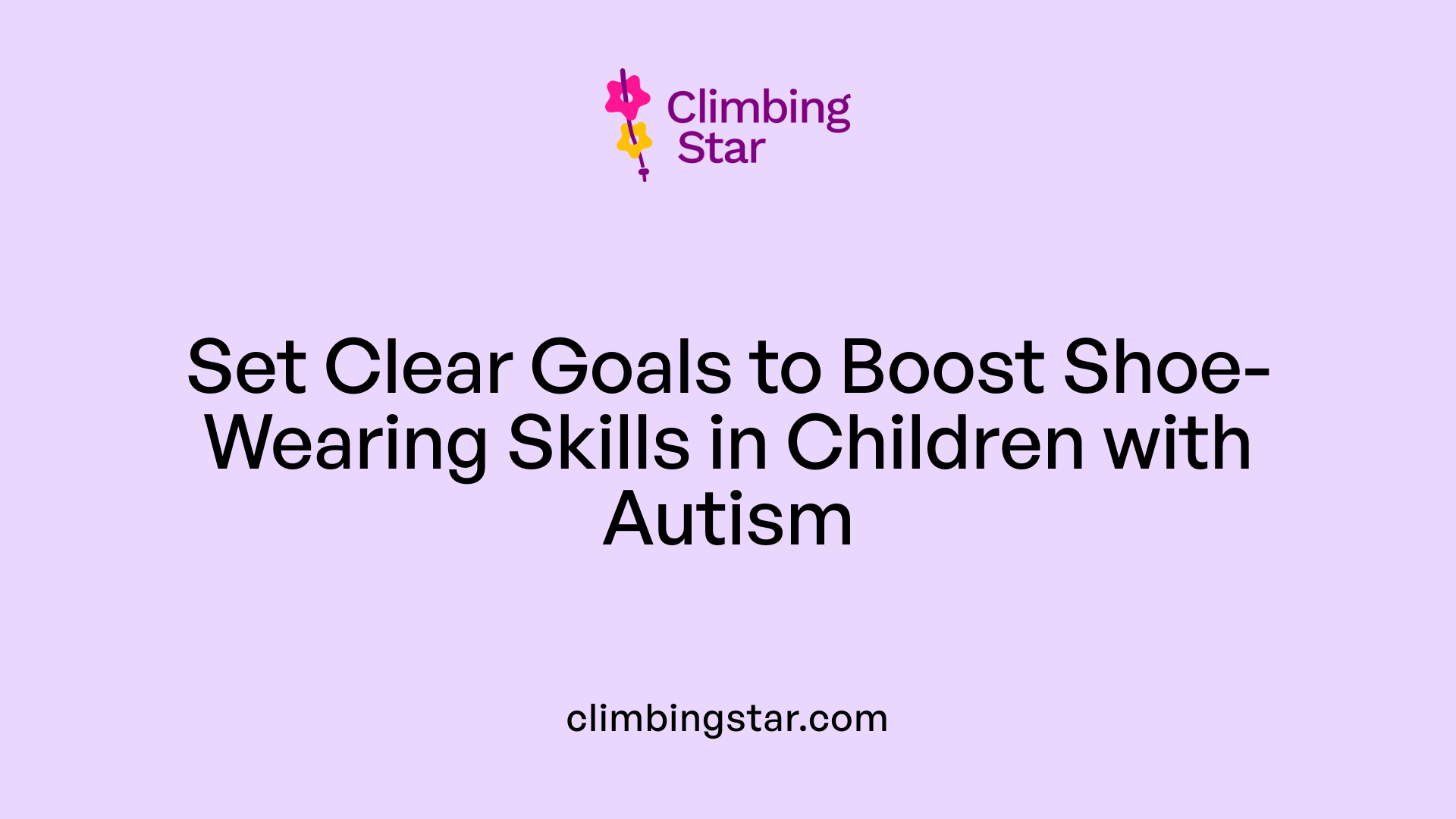Understanding the Challenge
Many parents and caregivers face the challenge of helping autistic children keep their shoes on, a seemingly simple task that can be complicated by sensory sensitivities, behavioral factors, and emotional responses. This article explores effective strategies grounded in behavioral therapy, sensory supports, and routine management to address this common concern, fostering comfort, independence, and cooperation.
Applying ABA Therapy to Encourage Shoe Wearing

What is Applied Behavior Analysis (ABA) therapy and how does it help individuals with autism?
Applied Behavior Analysis (ABA) therapy is a scientifically supported approach that uses principles of learning and behavior to help individuals with autism develop essential skills and reduce problematic behaviors. It involves analyzing environmental factors influencing behavior through the antecedent-behavior-consequence (A-B-C) framework. By breaking down complex tasks into small, manageable steps and reinforcing correct responses with rewards, ABA teaches skills like wearing shoes effectively. Tailored ABA programs improve communication, social, academic, and daily living skills, promoting independence.
How ABA helps with behavior and skill development
ABA focuses on teaching skills through structured, individualized methods. By identifying specific target behaviors, therapists use reinforcement to encourage positive actions while reducing undesired behaviors. This supportive environment helps the individual learn new skills systematically, enhancing overall functioning in daily life.
Breaking down tasks into smaller steps
In ABA therapy, complex actions like putting on shoes are divided into smaller, simpler steps. For example, "pick up the shoe," "put the foot inside," and "fasten the strap" are taught one at a time. This stepwise method makes learning manageable, fostering success and building confidence.
Positive reinforcement techniques
Correct responses during the learning process are immediately rewarded to increase the likelihood of repetition. Rewards can include praise, tokens, or preferred items or activities. This positive reinforcement motivates the child to continue practicing shoe wearing and helps establish the behavior more firmly.
ABA therapy’s thoughtful combination of task breakdown and reinforcement encourages mastery of skills such as shoe wearing, supporting greater independence and daily living proficiency for children with autism.
Who Provides ABA Therapy and Their Role in Supporting Shoe Wearing

Qualifications of ABA therapists
ABA therapy is delivered by trained professionals who specialize in behavioral analysis and autism spectrum disorders. These include Board Certified Behavior Analysts (BCBAs) and Registered Behavior Technicians (RBTs). BCBAs typically hold advanced degrees and have completed rigorous certification processes, equipping them with in-depth knowledge to design effective, individualized programs.
Roles of BCBAs and RBTs
BCBAs develop and supervise ABA treatment plans tailored to each child's unique needs, such as learning to wear shoes. They ensure that interventions use structured steps and appropriate reinforcement strategies. RBTs and other therapists carry out these plans one-on-one, providing guidance and reinforcement during learning sessions.
Supervision and individualized program design
An essential part of ABA therapy is ongoing supervision by BCBAs. They monitor progress, phase out prompts systematically to encourage independence, and adjust strategies as needed. This ensures that skills, like shoe wearing, are taught efficiently and effectively.
Importance of trained professionals in skill development
The involvement of qualified professionals is crucial in skill development for children with autism. Their expertise enables the creation and implementation of appropriate interventions that build confidence and independence in daily living skills, including shoe wearing, through consistent, positive reinforcement and tailored teaching methods.
Behavioral Goals Specific to Wearing Shoes

What are common behavioral goals targeted in autism therapy through ABA?
Applied Behavioral Analysis (ABA) therapy often sets behavioral goals focused on enhancing communication skills, boosting independence, and managing challenging behaviors. When it comes to shoe wearing, specific goals are tailored to support the child's abilities and needs.
Communication skills related to shoe wearing
Children are taught to use functional communication, such as requesting help or expressing preferences related to shoe wearing. This might include signaling when they want a particular pair of shoes or indicating discomfort with shoe textures.
Promoting independence in dressing
ABA therapy breaks down the process of putting on shoes into simple, manageable steps. Therapists encourage children to follow multi-step directions and gradually fade prompts so that the child can independently put on and remove shoes.
Managing challenging behaviors linked to shoe removal
Some children may engage in behaviors such as frequently removing their shoes. ABA addresses this by avoiding reinforcement of these behaviors and identifying triggers to reduce their occurrence. Replacement behaviors and coping strategies are taught to support tolerance.
Use of measurable and tailored goals
Goals related to shoe wearing are individualized and measurable, focusing on functional skills that promote autonomy. Progress is tracked systematically, ensuring the objectives are clear and achievable while supporting overall daily living skills.
Through this structured and personalized approach, ABA therapy helps children with autism build skills essential for everyday routines like shoe wearing, enhancing their independence and reducing frustration.
Typical ABA Therapy Sessions for Developing Shoe Wearing Skills
How is ABA therapy typically delivered and what does a typical session look like?
ABA therapy is delivered in an intensive, one-on-one format by trained professionals. Sessions often take place in clinics, homes, or schools, providing a familiar, supportive environment for the child.
One-on-one therapy structure
In these sessions, the therapist focuses entirely on one child, which allows close monitoring and individualized instruction tailored to the child's pace and needs.
Use of discrete trial training (DTT) and natural environment teaching (NET)
A primary method used is discrete trial training, where the complex skill of shoe wearing is broken down into smaller, manageable steps such as:
- Picking out shoes
- Putting feet into shoes
- Fastening laces or straps
Each step is practiced repeatedly with clear, short instructions and prompt reinforcement for correct responses.
Alongside DTT, natural environment teaching reinforces these skills during real-life situations, encouraging generalization outside of the therapy sessions.
Role of prompts and visual supports
Therapists make systematic use of prompts such as verbal cues or hand-over-hand assistance to guide the child initially. These prompts are gradually faded as the child gains independence.
Visual supports like picture schedules or First-Then boards help clarify what is expected, making the learning process smoother and less stressful.
Data collection and caregiver involvement
Throughout the session, therapists collect data on the child's responses and progress towards mastery of shoe wearing skills. This objective data informs ongoing adjustments in teaching strategies.
Caregivers are involved closely, receiving coaching to use similar prompts and reinforcement techniques at home. This consistency between therapy and home settings supports faster learning and generalization of skills.
Using Visual Supports and Social Stories to Promote Shoe Wearing

How Do Visual Schedules and First-Then Boards Help?
Visual schedules and First-Then boards offer clear, predictable cues that break down the shoe-wearing process into manageable steps. For a child with autism, seeing the sequence of activities laid out visually reduces confusion and enhances understanding. These tools promote independence by signaling what to expect next, making the task less overwhelming.
What Role Do Social Stories Play in Explaining Shoe Wearing Steps?
Social stories provide personalized narratives with pictures that describe each step involved in putting on shoes. They prepare children for transitions by clarifying expectations and possible outcomes. This storytelling approach helps reduce anxiety by addressing uncertainties surrounding the shoe-wearing routine.
How Do These Methods Reduce Uncertainty and Anxiety?
By offering consistent, concrete information about what will happen, visual supports and social stories minimize surprises. This predictability fosters a sense of safety and control, which lowers anxiety often experienced by children facing new or complex tasks such as shoe wearing.
In What Ways Do Visual Supports Enhance Predictability and Structure?
These aids create a structured environment that guides the child through the activity step-by-step. Visual schedules serve as daily roadmaps, while First-Then boards use simple, motivating prompts that encourage the child to complete one action before moving onto the next. This framework instills routine and clarity, crucial for successful skill acquisition.
Together, visual supports and social stories empower children to engage confidently with shoe wearing by making the experience understandable, manageable, and emotionally safe.
Incorporating Sensory Tools to Address Sensitivities Around Shoes
What are common sensory challenges with shoe textures?
Many children with autism experience heightened tactile sensitivities, making shoe textures uncomfortable or overwhelming. Materials like stiff leather, rough seams, or Velcro straps can cause distress, leading to resistance in wearing shoes. Understanding these sensitivities is essential for supporting children through this challenge.
How can sensory tools like fidget toys and sensory bins help?
Sensory tools play a vital role in managing discomfort related to shoes. Fidget toys can provide focused sensory input that distracts from the unpleasant sensations of shoe materials. Sensory bins filled with soft or textured objects allow children to explore tactile experiences in a controlled way. These tools help regulate sensory input and prepare children for handling different shoe textures.
What calming strategies assist in regulating emotions?
Calming techniques such as coloring, using calm-down cards, practicing mindfulness, and grounding exercises help children manage emotional responses around shoe-wearing. Designated retreat zones can offer safe spaces when the sensory experience becomes overwhelming. Incorporating these strategies reduces anxiety and promotes emotional regulation during shoe-related activities.
Why is gradual sensory exposure to shoes important?
Gradual exposure involves slowly introducing different shoe types and textures in low-pressure settings to build tolerance. This approach might start with touching or holding a shoe, followed by brief periods of wearing them, and eventually extending to full-time use. Combining this method with sensory tools and calming strategies fosters confidence and adaptability.
By integrating sensory tools, calming techniques, and gradual exposure, caregivers and educators can effectively support children with autism in overcoming sensitivities linked to shoes, promoting comfort and independence.
Maintaining Familiar Routines and Comfort Objects During Transitions
Why Are Consistent Routines Important for Wearing Shoes?
Consistency in routines, such as wearing shoes at specific times, provides predictability that helps children with autism feel secure. Familiar schedules reduce anxiety related to changes and unexpected events, making transitions smoother. For instance, incorporating shoe wearing into daily routines like before leaving the house or after playtime helps the child know what to expect.
How Can Shoe Wearing Be Included in Daily Schedules?
Visual schedules can outline when shoe wearing happens, using pictures or symbols to cue the child. This clear structure supports understanding and independence. A "First-Then" board might show "First put on socks, then shoes," guiding the steps clearly. Therapists and caregivers can gradually reduce prompts as the child becomes more comfortable and confident.
What Role Do Comfort Items Play in Reducing Distress?
Familiar objects like a favorite toy or blanket offer emotional security during transitions. When a child feels uneasy about changing shoes or entering a new environment, having a comfort item nearby can calm nerves and provide reassurance. These items act as tangible reminders of safety and familiarity.
What Strategies Help When Transitioning Involving Shoe Changes?
Preparatory steps such as visiting the environment where shoe changes happen and meeting caregivers can decrease uncertainty. Using social stories with images explaining the shoe change process helps the child understand what will happen. Gradual exposure and practice of shoe-related routines in low-stress settings build confidence. Collaborating with educators and therapists ensures that shoe wearing fits smoothly into the child's overall transition plan.
Collaborating with Educators and Therapists for Consistent Support

Sharing Child's Shoe Wearing Strategies with School Staff
Comfort with shoe wearing can be a challenge for some children with autism. Parents and therapists can help by sharing specific strategies that have been effective at home during school meetings or communications. This might include preferred shoe types, sensory-friendly socks, times when shoes are most tolerated, or calming techniques used to ease distress. By informing school staff of these small but important details, the child experiences less discomfort and resistance in the school setting.
Preparing Profiles and Safe Spaces
Creating a detailed profile that outlines a child’s likes, dislikes, sensory preferences, and behavioral triggers is essential. This profile should be shared with educators and therapists to ensure understanding and continuity in support. Equally important is the development of safe spaces within the school or therapy environment. These quiet, low-stimulation areas give the child a place to retreat when feeling overwhelmed, supporting emotional regulation and reducing stress.
Promoting Consistency Across Home, School, and Therapy Environments
Consistency is crucial for children with autism to generalize learned skills. Collaboration among families, educators, and therapists helps harmonize approaches and expectations. For example, if a child is learning a new social skill or coping strategy, using the same prompts, reinforcement systems, and visual supports across all settings strengthens learning and reduces confusion.
Importance of Teamwork in Skill Generalization
Teamwork facilitates the sharing of observations about the child's progress, challenges, and responses to interventions. Regular communication helps adjust strategies promptly and ensures that everyone is working toward common goals. This collective effort promotes the transfer of skills from structured therapy sessions to naturalistic settings like school and home, enhancing the child’s independence and confidence.
Encouraging Emotional Expression and Empathy to Support Cooperation
Using Emotion Cards to Recognize Feelings About Shoe Wearing
Emotion cards are a practical tool to help children with autism identify and express their feelings regarding specific situations, such as wearing shoes. By showing cards depicting different emotions, children can match their current feelings to the images, making the abstract concept of emotion more concrete. This recognition supports emotional literacy and prepares them to communicate their needs effectively.
Validating Child's Emotions
Acknowledging a child's feelings is essential for emotional development and cooperation. When a child expresses discomfort or resistance, such as when asked to wear shoes, validating their feelings by saying things like, "I see that putting on shoes is upsetting you," helps them feel understood. This validation strengthens trust and reduces frustration, making it easier to guide them towards desired behaviors.
Empathy-Building Story-Based Activities
Engaging children in story-based empathy activities fosters perspective-taking and emotional understanding. For example, stories that prompt questions like "What would you do if you felt uncomfortable wearing shoes?" encourage children to connect with characters' feelings and develop empathy. These activities enhance social awareness and promote cooperative behavior by helping children relate to others' experiences.
Reducing Resistance Through Emotional Understanding
By combining emotion recognition and empathy-building, caregivers and educators can reduce resistance to tasks like shoe wearing. Understanding a child's emotional state allows for tailored approaches that may include adjusting the sensory aspect of shoes or introducing comforting routines. Emotional support creates a more positive environment, leading to increased willingness to cooperate and participate.
Incorporating Play and Special Interests to Increase Motivation
How does Pivotal Response Treatment use play to increase motivation?
Pivotal Response Treatment (PRT) is a play-based therapy that enhances pivotal behaviors such as motivation and initiation of communication. By focusing on these core areas, PRT helps improve social skills, communication, and academic performance. Because it uses play, children stay engaged, making learning enjoyable and effective. Therapists and parents work together to consistently use this approach at home and in clinical settings, reinforcing positive behaviors through activities the child finds fun and motivating.
How can shoe wearing be embedded into a child’s favorite activities?
To encourage shoe wearing in autistic children, incorporating the task into activities they love can make the process less stressful and more appealing. For example, if a child enjoys playing with cars or puzzles, shoe wearing can be a part of the game, such as "shoes power up your race car" or "shoes help you get ready for adventure". This strategy connects the desired behavior to something meaningful, increasing the chance the child will participate willingly.
What role do interests play in increasing motivation?
Using a child’s special interests is a powerful motivator. When lessons or tasks center around what the child enjoys, their focus and willingness to engage improve significantly. For shoe wearing, incorporating favorite colors, characters, or themes on the shoes themselves or the related activities captures attention and enthusiasm.
How do games and engagement help teach shoe wearing?
Games offer a natural way to teach and reinforce shoe wearing. Activities like "The Name Game" or story-based scenarios can be adapted to include putting on shoes as part of social engagement and routine-building. Engaging children in interactive games turns the learning process into a fun challenge, promoting independence and reducing resistance.
By combining play-based treatments like PRT with personalized interests and engaging games, caregivers and therapists can effectively motivate children with autism to wear shoes, creating positive experiences linked with this essential daily skill.
Summary and Encouragement
Helping an autistic child keep their shoes on involves a multifaceted approach combining evidence-based behavioral therapies like ABA, sensory supports, visual aids, and emotional understanding. Consistency, patience, and collaboration among families, therapists, and educators are key to fostering independence and comfort. By breaking down the task into manageable steps, using motivating reinforcements, and respecting the child's unique needs, caregivers can successfully support this essential daily living skill, promoting confidence and autonomy.
References
- Behavioral Therapy for Autism Spectrum Disorder in Children
- Autism Transition Strategies: Helping Children Adapt with ...
- 24 Classroom Activities for Kids with Autism
- Applied Behavior Analysis (ABA)
- ABA Therapy Goals: 25 Practical Examples & Timelines
- Applied Behavior Analysis (ABA)
- How to Set ABA Goals: A Step-by-Step Guide







